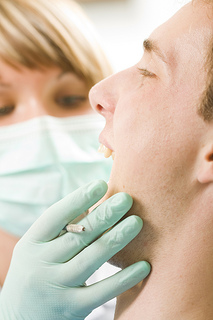Whitening Teeth with Braces
September 3rd, 2019

Now that you are working hard to improve your dental health and appearance with your braces, it might seem like a logical time to whiten your teeth as well. But should you go ahead with home kits or a professional whitening? The answer might be yes, but not quite yet!
Toothpaste
The easiest way to whiten teeth is regular use of a whitening toothpaste. But these do not make a major difference in tooth color and may also contain abrasives which can damage ceramic brackets and make them more likely to stain. And, whether you have metal or ceramic braces, the brackets used are bonded to your teeth. Any part of your tooth covered by a bracket will not be affected by the whitening paste. Ask our office if you are thinking of using one of these products. We will be happy to recommend the best toothpastes to use while your braces are in place.
Whitening Strips and Trays
Whiteners can be applied at home with strips or tray kits. Strips are coated with a whitening gel and then pressed around your teeth. Tray kits provide a mouthguard-like appliance, which is filled with whitening gel. But neither strips nor tray solutions will whiten any area covered by brackets. When your braces come off, there might be noticeable differences in color on each tooth. Strips are difficult to apply with braces, and trays need to be custom-designed to fit your braces and make sure they don’t disturb your orthodontic work. One size most definitely does not fit all! Finally, these whitening agents can cause tooth and gum sensitivity, especially around the time of adjustments. Many manufacturers do not recommend using their products while you have braces. Please talk to us if you are thinking of using them.
Professional Whitening
A dental professional can whiten your teeth in office for the best possible results. The most effective treatments for your unique teeth are combined with protective care of your gums and mouth. Whether this treatment is appropriate while you have braces is something we are happy to discuss.
The best way to keep your teeth bright is to keep up your regular dental routine! Brushing and flossing are more important than ever now, because plaque builds up around brackets. Avoid foods that stain teeth and rinse or brush after every meal and snack. Drs. Angela Paros, Amer Atassi, Eric Young, Alexander Katsnelson will show you the best way to take care of your teeth while your braces are on—and that includes the best way to keep them white and bright. Talk to us about the perfect time to whiten your beautiful smile during your next visit to our Romeoville, IL office. And if you have to wait a few extra days for the smile you’ve been working toward, truly, the wait will be worth it!
The Five Most Common Reasons for Emergency Visits
August 27th, 2019

An emergency usually evokes panic, and for good reason. Emergencies don’t discriminate when it comes to time or place. They’ll happen during your vacation, at home, while you’re shopping for groceries, at the movies … whenever they can.
We’ve identified the five most common reasons for emergency visits to our office, so if you ever find yourself in one of these situations, don’t hesitate to reach out and schedule an appointment with us!
- Getting a piece of food stuck where it doesn’t belong. This might sound trivial, and even comical, but a piece of food stuck and left unattended can cause inflammation, pain, and a serious infection.
- Losing a filling. If this happens to you, it’s crucial that you receive care immediately. The purpose of a filling is to shut off a space where bacteria can enter. If that barrier is breached, your tooth becomes more vulnerable to decay.
- A chipped tooth. Even if the chip is small, it’s essential to get it repaired before it grows bigger. Unless chips are affecting a nerve, they are usually easy to repair with a crown, bonding, or veneers.
- A broken tooth. This can result from a small, hidden chip in the tooth. It’s clearly something to address quickly, because the pain will be much more severe than what you’ll feel with just a chip.
- Losing the entire tooth. This is the worst of the list. When you lose a tooth, you should not delay in seeking emergency care. Usually, you have a window of one to two hours during which the original tooth can be salvaged and successfully reattached.
Though any of these scenarios can be nerve-wracking, Drs. Angela Paros, Amer Atassi, Eric Young, Alexander Katsnelson and our team are here to assist you with any and all dental emergencies. Don’t wait; give our Romeoville, IL office a call!
Fluorosis: What is it?
August 20th, 2019

Many people think dental fluorosis is a disease, but it’s not; it’s a condition that affects the appearance of your tooth’s enamel, not the function or health of the teeth. These changes may vary from tiny, white, barely noticeable spots to very noticeable staining, discoloration, and brown markings. The spots and stains left by fluorosis are permanent and may darken over time.
Dental fluorosis occurs in children who are excessively exposed to fluoride between 20 and 30 months of age. Only children ages eight years and younger can develop dental fluorosis. Why? That is the period when permanent teeth are still developing under the gums. For kids, fluorosis can cause significant embarrassment and anxiety about the appearance of their teeth. No matter how much they might brush and floss, the fluorosis stains do not go away.
Many well-known sources of fluoride may contribute to overexposure, including:
- Fluoridated mouth rinse, which young children may swallow
- Bottled water which is not tested for fluoride content
- Inappropriate use of fluoride supplements
- Exposure to water that is naturally or unnaturally fluoridated to levels well above the recommended levels
One way to reduce the risk for enamel fluorosis is to teach your children not to swallow topical fluoride products, such as toothpaste that contains fluoride. In fact, kids should use no more than a pea-sized amount of fluoride toothpaste when brushing, and children under the age of two shouldn’t use fluoride toothpaste at all.
Dental fluorosis can be treated with tooth bleaching, microabrasion, and conservative composite restorations or porcelain veneers. Please give us a call at our office to learn more or to schedule an appointment with Drs. Angela Paros, Amer Atassi, Eric Young, Alexander Katsnelson.
Sleep Apnea and Snoring
August 13th, 2019

Snoring may not be something you take seriously. You might even laugh or joke about it. But the fact is, anytime you or your partner snore to the point of waking, it could be a sign of serious health problems.
Sleep Apnea and Its Effects
Sleep apnea is a sleep disorder that is potentially dangerous, and the most common symptom is loud snoring. Breathing repeatedly starts and stops throughout the night, and you wake up feeling tired. Other serious effects from sleep apnea could be potentially dangerous to your health if left unaddressed.
Besides losing a good night's sleep, you may experience difficulty concentrating. Depression, risk of heart attack, irritability, high blood pressure, memory loss, sexual dysfunction, and chances of stroke all increase when sleep apnea is not treated.
Sleep apnea occurs when the muscles in the back of the throat relax to the point of inhibiting natural breathing. The muscles used to support the soft palate relax and the airway closes, causing breathing to stop for ten to 20 seconds. This lowers the oxygen level in the brain. As the brain senses the inhibited oxygen levels it rouses the sleeper awake so the airway can reopen. Normally, the reawakening is so brief the person won't remember it.
If you think you may have sleep apnea, visit our Romeoville, IL office and let Drs. Angela Paros, Amer Atassi, Eric Young, Alexander Katsnelson determine what treatment is needed. Without it, you could risk losing more than a restful night's sleep.
Prevention and Treatment
Anyone can develop sleep apnea, but it is more common among middle-aged adults who are overweight. Drs. Angela Paros, Amer Atassi, Eric Young, Alexander Katsnelson can help you determine the cause and suggest positive treatment.
A common treatment for apnea is the placement of oral devices that are designed to help keep the airway open. By bringing the jaw forward, the device opens the airway and thereby discourages snoring. We are experienced in sleep apnea appliances, and Drs. Angela Paros, Amer Atassi, Eric Young, Alexander Katsnelson can prescribe a fitted device and monitor its success with follow-up therapy.
A continuous positive airway pressure mask, known as a CPAP, is among the other treatment options. A mask is fitted over the mouth and forces oxygen through the throat while you sleep. The pressure holds the soft tissue and throat muscles open.
Our professionals at High Point Dental Group can advise you of other ways to prevent sleep apnea, including weight loss, avoiding alcohol, or alternative sleeping positions. We can help you sleep return to easy sleep, knowing you are safer and healthier during your resting hours.






